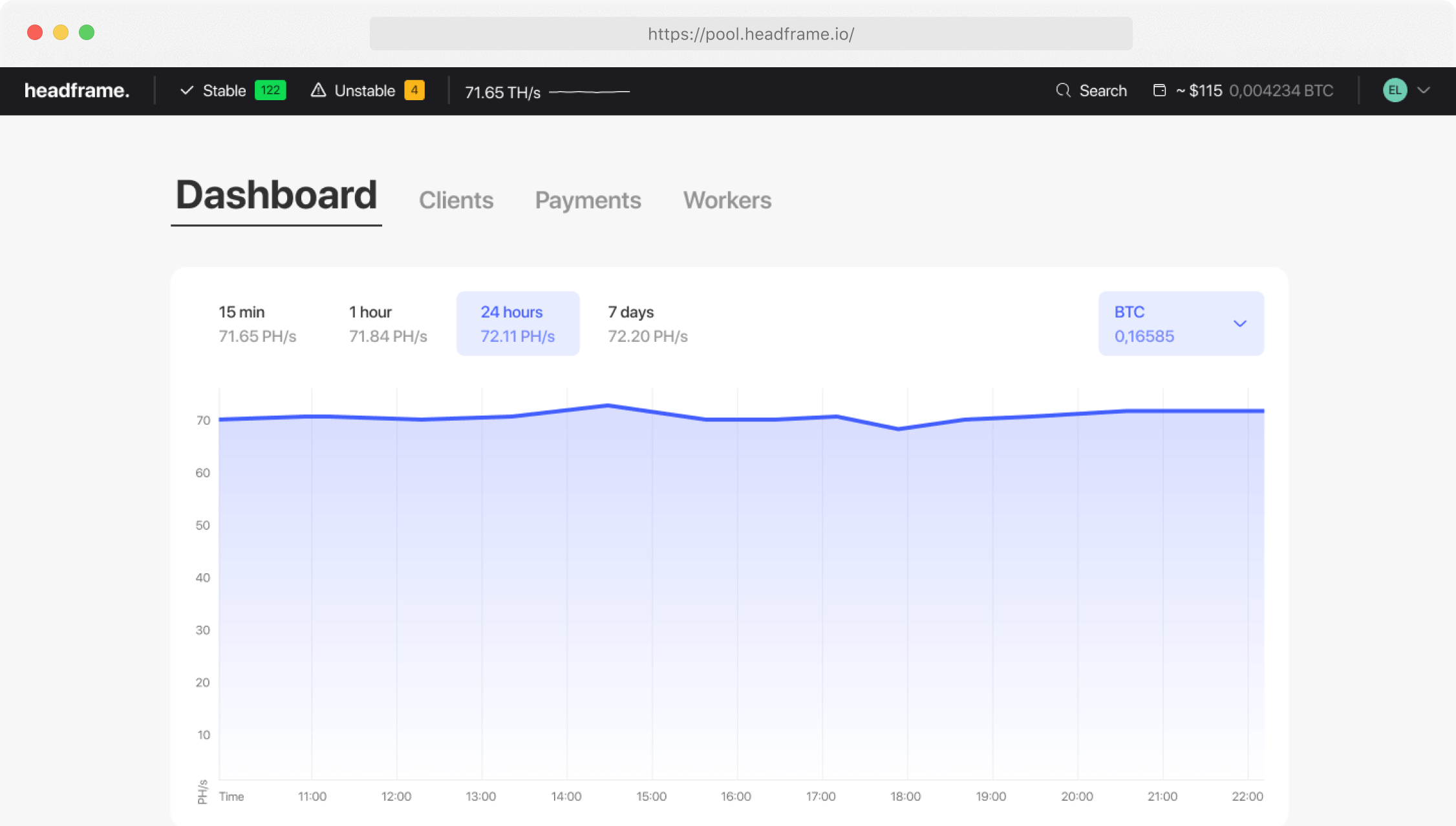Strategies for Ensuring Continuous Operation of Mining Pools
Mining pools play a crucial role in the cryptocurrency industry by aggregating miners’ computational power for more effective digital asset extraction. Ensuring the continuity of mining pool operations is critically important, affecting their efficiency, stability, and profitability. Let’s explore various strategies that mining pools can use to minimize risks and ensure continuous operation.
Earn more money with Headframe
Join a mining pool and get the best profitability in mining. Already more than 10,000 miners trust Headframe.
Mining pools rely on several factors that can impact their stability and performance. One key aspect is managing equipment and infrastructure. Ensuring continuous operation requires using reliable and high-quality equipment capable of enduring long periods of operation without failure. Regular maintenance and timely equipment upgrades help minimize the risks of breakdowns and downtime. Having backup equipment that can be deployed in case of main device failure is also crucial.
Power Supply
Power supply plays a vital role in the stable operation of mining pools. Power outages can halt mining operations and lead to revenue loss. To ensure reliable power supply, mining pools use various methods, such as connecting to multiple independent power sources, using backup generators, and deploying uninterruptible power systems (UPS). Switching to renewable energy sources, such as solar and wind power, also helps improve power supply reliability and reduce dependence on traditional power grids.
Data Security
Data security and protection against cyber threats are other critical aspects of ensuring continuous operation of mining pools. Cyber-attacks and breaches can lead to data leaks, fund theft, and pool shutdowns. To protect against such threats, mining pools use advanced data encryption methods, multi-factor authentication, and regular security audits. Implementing monitoring and anomaly detection systems helps timely identify and prevent potential threats.
Software Stability
Software stability is also important for the continuous operation of mining pools. Using reliable and proven software helps minimize the risks of failures and errors. Regular software updates, bug fixes, and the addition of new features enhance performance and security. Having backups of data and software that can be restored in case of a failure or attack is also crucial.
Financial Management
Financial management and ensuring stable income also play a vital role in the continuity of mining pools. Developing and adhering to budgets, monitoring income and expenses, and creating reserve funds help mining pools navigate periods of low profitability and maintain financial stability. Financial planning and forecasting allow for strategies to minimize risks and adapt to market changes.
Participant Interaction
Interaction with pool participants and supporting their engagement is also essential for ensuring continuous operation. Maintaining an active dialogue with participants, providing quality technical support, and educating them on new methods and technologies help improve interaction and satisfaction. Educational initiatives and training sessions help participants better understand and use modern technologies, leading to more efficient work and increased income. Active engagement with participants helps mining pools quickly address emerging issues and adapt to changes.
Technological Innovations
Technological innovations and the implementation of advanced technologies help improve the efficiency and stability of mining pools. Using energy-efficient equipment, optimizing mining algorithms, and implementing automated management systems help increase productivity and reduce costs. Investments in research and development ensure the pool’s competitiveness and sustainable growth. Modern energy management technologies and the use of renewable energy sources contribute to reducing costs and improving the environmental sustainability of mining operations.
Regulatory Compliance
Regulatory changes can significantly impact the operation of mining pools, so compliance with legislation and interaction with regulators is vital. Mining pools must monitor regulatory changes and adapt to new requirements to avoid legal issues and ensure the legitimacy of their operations. Transparency and adherence to regulatory requirements strengthen the trust of participants and investors, contributing to stability and income growth.
Partnerships and Collaboration
Partnerships and collaboration with other mining pools and companies also play an important role in ensuring continuous operation. Combining efforts and sharing knowledge and resources help mining pools develop and implement new technologies, improve infrastructure, and enhance operational efficiency. Partnership relationships foster the creation of a global ecosystem where innovations can quickly spread and adapt to various conditions. This contributes to the overall resilience and competitiveness of mining pools.
Social and Environmental Responsibility
Social and environmental responsibility are also important for mining pools. Supporting environmental initiatives and using renewable energy sources help reduce the carbon footprint of mining operations and improve their environmental sustainability. Participating in social projects and supporting local communities also help strengthen ties with participants and improve their trust in the pool. This helps create a more sustainable and inclusive cryptocurrency ecosystem.
In conclusion, ensuring the continuity of mining pool operations depends on several factors. Managing equipment and infrastructure, power supply, data security, software stability, financial management, participant interaction, technological innovations, regulatory compliance, partnerships, and supporting social and environmental responsibility all play vital roles in maintaining the stability and efficiency of mining pools. Understanding and implementing these strategies help mining pools effectively navigate challenges and seize opportunities to achieve long-term success in the cryptocurrency industry.


